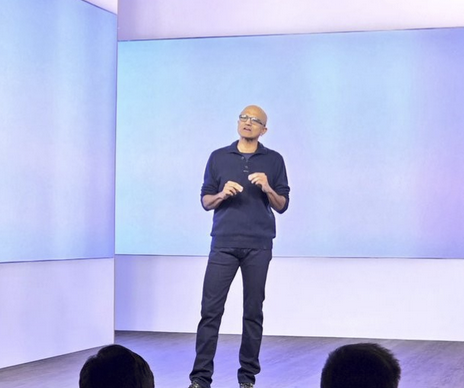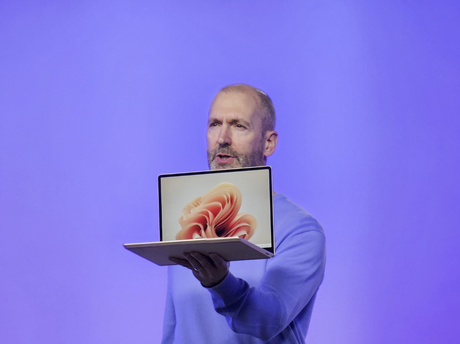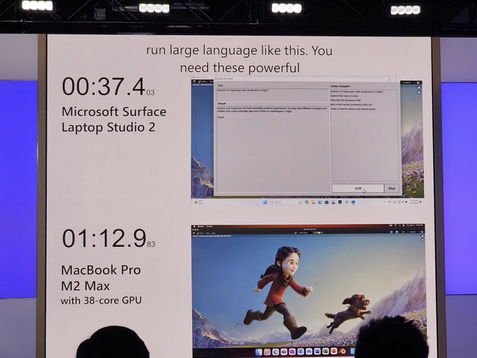Satya Nadella at the Microsoft Surface and AI event. Source Patrick Moorhead
In October Microsoft held an event focused on artificial intelligence (AI) and Surface, announcing its new Copilot for Windows 11 and four new Surface devices. Microsoft’s launch of new Surface products is one of my favorite events every year. Although Microsoft did not announce as many devices this time as it has in the past, it made up for it with the debut of its innovative Windows 11 Copilot.
It was no surprise that Microsoft was going to include some integration of its AI-driven Copilot into Windows 11. Moor Insights & Strategy analyst Melody Brue has written many great pieces following Microsoft’s AI journey, including Bing AI search, Bing AI search for Enterprise and her recent coverage of the Surface and AI event. You can also read my piece on Microsoft’s AI and copilot announcement at Build 2023. In this piece, I want to share some directional insights about Microsoft’s Copilot for Windows 11 and how Microsoft is using its Surface devices to drive AI computing.
https://youtu.be/RGWfM7td2oo?si=fI8u5EjFQgORYIUD
Microsoft AI and Surface Event — The Six Five podcast
Let’s talk about Windows 11 Copilot
Microsoft CEO Satya Nadella described Copilot for Windows 11 as one experience that runs across multiple contexts. It is not a replacement for your own work—not even your shallowest work—but an intelligent complement to your workflow. With Copilot, Microsoft wants to differentiate Windows 11 by enabling its users to be more productive by using generative AI (GAI). Remember, there are almost two billion active users of Windows 11, and if Microsoft is to capture a majority of those users and equip them with powerful AI tools, it must embed its AI tools into Windows 11 strategically.
I appreciate Nadella highlighting the new natural user interface (UI) for Windows Copilot, intentionally positioning it as a utility, not a workflow replacement. The key is that there are different copilots embedded in different areas of Windows 11 and Microsoft 365 applications, but it’s still one unified, holistic experience.
https://youtu.be/IzmX5R_Zlac?si=KHDiQz3Ed4GCkSQ7
Microsoft’s Latest Announcements and Their Vision for Gen AI — The Six Five on The Road
How the copilots handle the user’s data is important for enabling this new natural UI. I asked Nadella where the data comes from for training, inferencing and prompting these copilot experiences, especially for the enterprise. He said Microsoft will activate the data wherever it sits. Considering most enterprise data is on-prem, activating this data—presenting it as usable information for the worker—right there efficiently eliminates the extra steps of sending the data to the cloud for processing into useful information and then retrieving the answers. This solves a decade-and-a-half data problem of siloed on-prem data, and we should see a tangible increase in productivity from using Windows 11 Copilot in the enterprise.
At the event, Microsoft demoed some unique and exciting features and interactions that differentiate the Windows 11 user experience. One example Microsoft gave was asking the Copilot about flight plans, bringing in context from texts on the user’s phone. This new utility of pulling in context from the smartphone leapfrogs any smartphone integration that Apple has shown with macOS, and I do not say that lightly. Android has a huge install base, and with Microsoft’s recent introduction of PhoneLink for iOS, the iPhone is most definitely on the list for supported devices.
I was also blown away by the context that Copilot is able to bring in and by the GAI features that Microsoft is now including in apps like Paint, Snipping Tool and Photos that completely refresh these familiar Windows applications. These tools should be huge boosts for organizations. (Look for more details soon from Brue about those apps.)
Enabling the Copilot experience with new Surface devices
At the hardware level, Microsoft is enabling these new copilot experiences with the Surface Laptop Studio 2, the new Surface Go 4 for Business and the Surface Laptop Go 3. The Surface Go and Surface Laptop Go are entry-level devices that Microsoft introduced at the beginning of the pandemic. These devices uphold the premium Surface design while also being affordable.
The Surface Laptop Go 3 comes with an Intel Core i5 processor and an all-day battery life. It is Microsoft’s most portable notebook laptop, and it comes with the new Windows Copilot. Although it is slightly smaller than the 13-inch M1 and M2 MacBook Air laptops, it undercuts them on price by a couple of hundred dollars and does not skimp on Microsoft’s new AI capabilities. Considering that Copilot is run locally on the device and that memory allocation is crucial to the performance of large language models, memory is going to be very important for the Surface Laptop Go 3. I like it that Microsoft gives buyers the option of 8GB or 16GB of memory.
The Surface Laptop Go 3. Source Patrick Moorhead
The Surface Go 4 for Business was hardly mentioned at the Surface event, but it hits a similar stride to the Surface Laptop Go 3. It is available only to businesses as an affordable alternative to the Surface Pro for frontline workers. Microsoft says that the device’s Intel Processor N200 is 80% faster than its predecessor, with up to 12.5 hours of battery life. Although the Intel N200 is not powerful enough for these new Copilot features, it is positioned well to address the needs of frontline workers.
The Surface Laptop Studio 2 is incredibly powerful
The star of the show for the Surface brand was Microsoft’s new Surface Laptop Studio 2. If any device is intended to show off the innovative features of Microsoft Copilot, it is this one. Initially positioned as a replacement for the beloved Surface Book, the Surface Studio packs some serious firepower in a content creator-specific package. It looks more refined than the first edition released a couple of years ago, and it comes with a powerful 13th Gen Intel Core i7 processor with up to 64GB of memory and up to an Nvidia GeForce RTX 4060 GPU. These specifications, alongside the Studio 2’s touch and pen support, make it a very powerful content creator notebook. Adding Microsoft’s new GAI features makes the Studio 2 an incredibly powerful device.
I expect the Studio 2 to have much better battery life compared to the first generation because it now benefits from Intel’s P-cores and E-cores, which boost efficiency. Microsoft showed off some on-device AI and heavy-duty discrete GPU comparisons in which the Studio 2 smoked the MacBook Pro M2 Max.
Microsoft Surface Studio 2 versus MacBook Pro M2 Max running LLMs. Source Patrick Moorhead
While the base model Studio 2 does have a higher sticker price than the base model Surface Studio, that’s for a good reason. There is no longer an option for an Intel Core i5 processor model with the Studio 2, nor is there a 256GB storage option. The Studio 2 base model is configured with an Intel Core i7 with 16GB of memory, 512GB of storage and Intel Iris Xe graphics. There is a considerable jump in price, roughly $400, from the base mode Studio 2 to the next model up, with the difference being the discrete Nvidia GeForce RTX 4050. I expect the dedicated GeForce RTX 4050, 4060 and 2000 Ada discrete GPUs to show more performance under AI workloads such as faster copilot processing and GeForce RTX Studio features.
Wrapping up
My biggest critique of Microsoft is that it does not emphasize its “firsts.” Despite the building criticisms behind GAI, Microsoft was one of the first to successfully implement productive AI features in its products. It started in Bing search, and it’s the movement into Windows 11 Copilot is incredibly powerful. As Matt Barlow, Corporate VP, Microsoft Windows + Surface Marketing, said, great experiences pull people in, and I have no doubt Microsoft is doing this on the software level with Windows 11 and on the hardware level with these new Surface devices.
The Surface Laptop Studio 2 is an incredibly powerful device, not only with the raw speeds from Intel and Nvidia processors but also functionally with its touch screen and multi-modal support. I am interested in testing out the validity of Microsoft’s head-to-head comparisons with the MacBook Pro M2 Max. I suspect Studio 2 can run circles around the M2 Max for many workloads, especially with the help of Windows 11 Copilot, but I want to try it for myself.

























































































